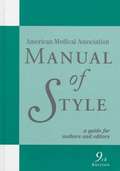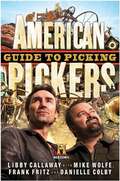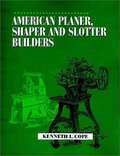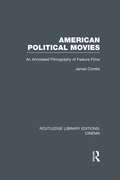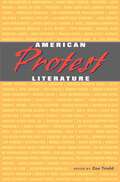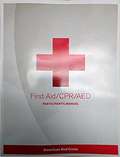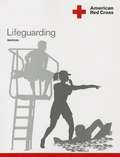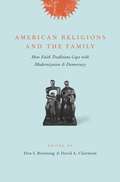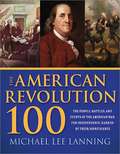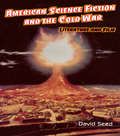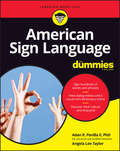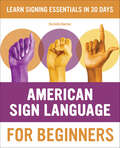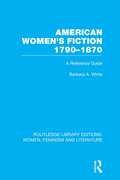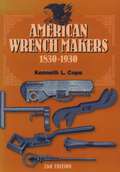- Table View
- List View
American Level Patents: Illustrated and Explained
by Don RosebrookIn this companion to American Levels and Their Makers, Vol. I, the author presents that great rarity a book on patents that both illustrates the patents (in a size large enough to be useful) and explains them. Two hundred and ten level patents are pictured and explained here, with explanations keyed to the patent drawings. They illustrate the major and continuing contributions by L.L. Davis, Justus Traut, the Stratton Bros., and L.S. Starrett, among others. To aid in identification, each patent is triply indexed: by date, patentee, and category (e.g., inclinometer, sighting level, adjustment mechanism, etc.). In addition, the book provides a brief history of the men who obtained the patents, information on whether, when, and how the patents were used, the progression of improvements in patent concepts over time, and information that may be useful in identifying mystery levels. This volume, relating patents to real tools, will prove an invaluable reference for tool collectors and dealers, as well as for students of industrial technology.
American Literature
by Directorate Of Distance and Continuing Education - Manonmaniam Sundaranar UniversityThe book published by the Directorate of Distance & Continuing Education, Manonmaniam Sundaranar University, Tirunelveli, explores the integral relationship between American literature and the nation's history, well-being, and cultural characteristics. Positioned as a mirror reflecting the multifaceted aspects of America, the book delves into the rich tapestry of literary works that not only chronicle the nation's historical evolution but also serve as a reservoir of the collective creative thoughts and imaginations of its people. From the early foundational texts to contemporary masterpieces, the synthesis of American literature emerges as an indispensable part of the nation's cultural identity, offering readers a profound insight into the intricacies of American society and its dynamic journey through time.
American Medical Association Manual of Style: A Guide for Authors and Editors (9th edition)
by Cheryl IversonThe latest edition features an expanded chapter on legal and ethical concerns in publishing. Readers will also find an extensive chapter on statistics, a completely updated chapter on nomenclature, new policies for eponyms and numbers styles, a larger references section, an expanded discussion of inclusive language and abbreviations, and a larger section on figures and tables. A new section on typography is also featured, along with current information on electronic publishing, encompassing rapid changes affecting the publishing environment. End-of-chapter references make the book easier to use, and the entire text is reviewed by more than 70 editors for accuracy and dependability.
American Milling Machine Builders 1820-1920
by Kenneth L. CopeContinuing the pattern set by American Lathe Builders and American Planer, Shaper and Slotter Builders, this is the first book to identify American builders of milling machines and the products they invented circa 1818 to the development of the "modern" milling machine circa 1920. Early versions of other American machine tools were largely copied from European, especially British, machines. The milling machine, however, was an American development. Built first for the firearms and sewing machine industries, it proved to be much more productive than other methods, and soon held a major place in all high-production American machine shops. The book lists more than 300 makers and contains over 1,400 illustrations taken from original catalogs and contemporary periodicals. These trace the development of the milling machine from a crude, light weight machine to very large millers capable of machining parts the size of boxcars and weighing many tons. Attachments such as dividing heads, vises, etc., are also covered.
American Music Librarianship: A Research and Information Guide
by Carol June BradleyThe literature of American music librarianship has been around since the 19th century when public libraries began to keep records of player-piano concerts, significant donations of books and music, and suggestions for housing music. As the 20th century began, American periodicals printed more and more articles on increasingly specialized topics within music studies. Eventually books were developed to aid the music librarian; their publication has continued over the course of nearly a century. This book reflects the great diversity of the literature of music librarianship. The main resources included are items of historical interest, descriptions of individual collections, catalogues of collections, articles describing specific library functions, record-related subjects, bibliographies designed for music library use, literature from Canada and Britain when relevant to U.S. library practices, key discographies, and information on specialized music research. The material is ordered by topic and indexed by author, subject, and library name.
American Patented Brace 1829-1924: An Illustrated Directory of Patents
by Ronald W. PearsonThis is a vastly expanded successor to Dr. Pearson s earlier Guide to American Brace Patents 1829 1910. Not only are many newly discovered patents included, but these are now cross-indexed and illustrated and, for the first time, the author provides an indication of their rarity. Over 500 brace patents are listed alphabetically by patentee name and chronologically by date and patent number. There is a third index that lists patents by type of brace in four major categories: brace ratchet patents, corner brace patents, brace wrench patents, and brace combination tool patents. An invaluable reference for anyone having an interest in these fascinating examples of American ingenuity.
American Philosophy: An Encyclopedia
by John Lachs Robert TalisseThe Encyclopedia of American Philosophy provides coverage of the major figures, concepts, historical periods and traditions in American philosophical thought. Containing over 600 entries written by scholars who are experts in the field, this Encyclopedia is the first of its kind. It is a scholarly reference work that is accessible to the ordinary reader by explaining complex ideas in simple terms and providing ample cross-references to facilitate further study. The Encyclopedia of American Philosophy contains a thorough analytical index and will serve as a standard, comprehensive reference work for universities and colleges. Topics covered include: Great philosophers: Emerson, Dewey, James, Royce, Peirce, Santayana Subjects: Pragmatism, Progress, the Future, Knowledge, Democracy, Growth, Truth Influences on American Philosophy: Hegel, Aristotle, Plato, British Enlightenment, Reformation Self-Assessments: Joe Margolis, Donald Davidson, Susan Haack, Peter Hare, John McDermott, Stanley Cavell Ethics: Value, Pleasure, Happiness, Duty, Judgment, Growth Political Philosophy: Declaration of Independence, Democracy, Freedom, Liberalism, Community, Identity
American Pickers Guide to Picking
by Libby CallawayA true adventure story and the go-to guide for "picking" American treasures from anyone's backyard, straight from the stars of History's American PickersIn these pages, professional treasure hunters Mike Wolfe and Frank Fritz chronicle their road trips across the American countryside in search of "rusty gold" to buy and sell among the picking world's one-of-a-kind characters. Whether you are a fan of the show or just like finding hidden riches, you will love seeing what Wolfe and Fritz dig up and enjoy meeting the devoted collectors, extreme stockpilers, and elite dealers who they encounter along the way.Wolfe and Fritz do not deal in fine antiques. Their secondhand treasures are of the down-and-dirty and sometimes even bizarre variety, from old bicycles and vintage tools, to sun-bleached cars and handmade furniture, retired carnival games and unusual taxidermy. Assisted by Danielle Colby, who helps out at Antique Archaeology, Wolfe and Fritz buy on the cheap and then sell to dealers, art directors, interior designers, or anyone looking for a little bit of authentic Americana. The three now share their secrets to finding hidden gems, offering helpful hints that will show what average Americans can do to find the treasures that await them.From American Pickers Guide to Picking:Junk is BeautifulWhen we knock on a door, 90 percent of the time the things we find are junk. But we don't care about the odds; a picker never turns down an opportunity, no matter where it is. We've picked pickup trucks. We've picked flat beds. We've picked dumpsters. We even picked a Mercury Sable. We're looking for the unusual, the impossible, the funky, the different, the bizarre-things we have never seen before. And we'll go anywhere we have to go to find it.No location is off-limits to a hard-core picker. And there's plenty of things to be found at antique stores, thrift and consignment shops, flea markets, estate sales, and swap meets, and a lot of the tips in this book apply to finding treasures at these joints. But that's not really the kind of picking we do anymore. We look outside the box to find our junk-a word we use almost like a term of endearment: to us: junk is beautiful.
American Planer, Shaper and Slotter Builders
by Kenneth L. CopeHere is the first book to identify American builders of planers, shapers and slotters, who operated throughout the 19th and early 20th centuries. Written in the style of the author?s previous groundbreaking books on the American machine tool industry, this volume provides the reader with invaluable information on over 300 makers. Some are very well known, but many have previously gone virtually unrecognized by researchers. More than 1000 illustrations, taken from original catalogs and contemporary periodicals, show how these machines developed: starting out in the early 1800s as crude, hand-built copies of English machines and becoming, over the course of a century, monster machines weighing nearly one million pounds, unmatched elsewhere in the world. Numerous machine accessories, such as chucks, dividing heads, milling attachments and keyseating attachments, among others, are identified and illustrated. In addition, the book includes a glossary of terms used in describing the various types of planers, shapers and slotters, and provides illustrations that help identify the individual parts of the machines.
American Poetry: The Next Generation
by Jim Daniels Gerald CostanzoThis book is an anthology of the many young poets, all born since 1960.
American Political Movies: An Annotated Filmography of Feature Films (Routledge Library Editions: Cinema)
by James CombsEssays here explore the relationship between politics and explicitly political feature films from the beginning of the movie industry to World War I, and for each decade through to the 1980's. The included filmography is particularly useful. Originally published in 1990, the method of inquiry put forward in this text is nonetheless extendable to the decades following its publication.
American Politics and the African American Quest for Universal Freedom
by Robert C. Smith Sherri L. Wallace Hanes Walton, Jr.American Politics and the African American Quest for Universal Freedom is known for its lucid style, student-oriented approach, and wide-ranging perspective. Designed to allow flexibility in teaching approaches, this tenth edition retains all the features that made previous editions so popular. All chapters have been updated with new content and the latest data available, including:• Inclusive and affirming language throughout.• Enhanced discussion on “Elements of Black Culture” and the political significance of African American music and the Black Church.• Black American public opinion and the various strands of African American ideology.• The CROWN Act, the politics of black hair, and the African American celebrity impact on politics.• Political significance of the increasing ethnic diversity of Black communities due to immigration from Africa and the Caribbean and the latest on “Black Lives Matter” discussion.• Discussion on the first Black sorority political action committee established in the U.S. and advocacy organizations serving the Black LGBTQIA+ community.• Characteristics of eligible and registered Black voters, the coverage of the 2024 presidential and congressional elections, and the results of the congressional elections with respect to partisan control of Congress and the size of the Black congressional delegation.• Demographic characteristics of the members of the 118th Congress now includes sexual orientation and generational data for comparison.• Race policies of former President Biden, reclassifying him as “antiracist.” An alternative method of ranking presidents that brings the views of Black experts to the conversation and includes a discussion of the record number of Black political appointments and policies implemented under Biden.• Confirmation hearing of the first Black woman, Justice Ketanji Brown Jackson, appointed to the Supreme Court. New material on the Voting Rights Act, Affirmative Action, and the Pigford cases testing institutional racism.• “Tennessee Three,” highlighting racism in the rare expulsion of two Black members of the Tennessee House of Representatives, and how Republican state-controlled legislatures are stunting the quest for universal freedom.• Revisions using the Urban League’s State of Black America “Equality Index,” as a measure of material well-being in the African American community, to examine historic and systemic patterns in structural inequities as manifested in economics, health, education, social justice, and civic engagement.• Updated Textbook Media Integration Guide featuring lecture power points, chapter summaries, critical thinking questions, the profiles and “Faces and Voices”, and the links to the biographical material and videos.American Politics and the African American Quest for Universal Freedom continues to offer a comprehensive, rigorous, and accessible understanding of how the presence of African Americans in the United States has profoundly influenced and influences American politics. It remains essential reading for all students of American Government, Black Politics, and African American Studies, particularly those approaching the study of race and politics for the first time.
American Privacy: The 400-year History of Our Most Contested Right
by Frederick S. LaneA page-turning narrative of privacy and the evolution of communication, from broken sealing wax to high-tech wiretapping.
American Protest Literature (The John Harvard library #99)
by Howard Zinn“I like a little rebellion now and then”—so wrote Thomas Jefferson to Abigail Adams, enlisting in a tradition that throughout American history has led writers to rage and reason, prophesy and provoke. This is the first anthology to collect and examine an American literature that holds the nation to its highest ideals, castigating it when it falls short and pointing the way to a better collective future.American Protest Literature presents sources from eleven protest movements—political, social, and cultural—from the Revolution to abolition to gay rights to antiwar protest. Each section reprints documents from the original phase of the movement as well as evidence of its legacy in later times. Informative headnotes place the selections in historical context and draw connections with other writings within the anthology and beyond. Sources include a wide variety of genres—pamphlets, letters, speeches, sermons, legal documents, poems, short stories, photographs, posters—and a range of voices from prophetic to outraged to sorrowful, from U.S. Presidents to the disenfranchised. Together they provide an enlightening and inspiring survey of this most American form of literature.
American Red Cross First Aid/CPR/AED: Participant’s Manual
by American Red CrossThis participant's manual is part of the American Red Cross First Aid/ CPR/AED program. This manual contains three parts: 1. First Aid Basics; 2. First Aid for Cardiac Emergencies and Choking; and 3. First Aid for Common Illnesses and Injuries.
American Red Cross Lifeguarding Manual
by American Red CrossDesigned to simplify learning, the participants manual reinforces key points from the course. The manual can also be used as a reference for working lifeguards after the course.
American Religions and the Family: How Faith Traditions Cope with Modernization and Democracy
by David A. Clairmont Don S. Browning Eds.Religions respond to capitalism, democracy, industrialization, feminism, individualism, and the phenomenon of globalization in a variety of ways. Some religions conform to these challenges, if not capitulate to them; some critique or resist them, and some work to transform the modern societies they inhabit. <P><P>In this unique collection of critical essays, scholars of Judaism, Christianity, Islam, Hinduism, Buddhism, Confucianism, and Native American thought explore the tension between modernization and the family, sexuality, and marriage traditions of major religions in America. Contributors examine how various belief systems have confronted changing attitudes regarding the meaning and purpose of sex, the definition of marriage, the responsibility of fathers, and the status of children. They also discuss how family law in America is beginning to acknowledge certain religious traditions and how comparative religious ethics can explain and evaluate diverse family customs.Studies concerning the impact of religious thought and behavior on American society have never been more timely or important. Recent global events cannot be fully understood without comprehending how belief systems function and the many ways they can be employed to the benefit and detriment of societies. Responding to this critical need, American Religions and the Family presents a comprehensive portrait of religious cultures in America and offers secular society a pathway for appreciating religious tradition.
American Revolution 100: The Battles, People, and Events of the American War for Independence, Ranked by Their Significance
by Michael Lee LanningA controversial ranking of the Revolution's biggest battles, events, and leaders. The American Revolution 100 brings you onto the charred battlefields and inside the maneuverings of the war that produced America. In comprehensive fashion it explains, analyzes, and ranks the war's most significant events, leaders, and battles according to their importance. Celebrated veteran and military expert Michael Lee Lanning introduces the war's various causes and primary players. The 100 ranked entries that follow include bloody battles, outspoken politicians, military heroes, causes of the conflict, and monumental events. The War of Independence pitted king against colonialist, monarchy against democracy. Men risked execution for treason in order to bring about the model government that would inspire a world. The American Revolution 100 brings to life its battles, people, and events, including maps and illustrations.
American Science Fiction and the Cold War: Literature and Film (America In The 20th/21st Century Ser. #Vol. 3)
by David SeedFirst Published in 1999. Routledge is an imprint of Taylor & Francis, an informa company.
American Sign Language For Dummies
by Angela Lee Taylor Adan R. Penilla IIGrasp the rich culture and language of the Deaf community To see people use American Sign Language (ASL) to share ideas is remarkable and fascinating to watch. Now, you have a chance to enter the wonderful world of sign language. American Sign Language For Dummies offers you an easy-to-access introduction so you can get your hands wet with ASL, whether you're new to the language or looking for a great refresher. Used predominantly in the United States, ASL provides the Deaf community with the ability to acquire and develop language and communication skills by utilizing facial expressions and body movements to convey and process linguistic information. With American Sign Language For Dummies, the complex visual-spatial and linguistic principles that form the basis for ASL are broken down, making this a great resource for friends, colleagues, students, education personnel, and parents of Deaf children. Grasp the various ways ASL is communicated Get up to speed on the latest technological advancements assisting the Deaf Understand how cultural background and regionalism can affect communication Practice signing with videos online If you want to get acquainted with Deaf culture and understand what it's like to be part of a special community with a unique shared and celebrated history and language, American Sign Language For Dummies gets you up to speed on ASL fast.
American Sign Language for Beginners: Learn Signing Essentials in 30 Days
by Rochelle BarlowA 30-day beginner's guide for learning American Sign LanguageThere's an easy way to leap right in to learning American Sign Language (ASL). American Sign Language for Beginners delivers 30 days of lessons that will help you sign with those in your home, community, and classroom.From letters and numbers to essential vocabulary and grammar basics, this beginner's guide provides the essentials needed to develop a solid foundation for American Sign Language in the real world. Each daily lesson takes less than 30 minutes to complete and focuses on a single set of vocabulary or ASL grammar. Throughout the course, you'll find key phrases, helpful memory tips, signing practice activities, and insight into deaf culture. Start your ASL masterclass today.American Sign Language for Beginners includes:30 Days of easy ASL—Start off right with an accelerated plan designed to help you begin signing in just one month.Easy-to-understand instructions—Lessons concentrate on a single idea or subject and include photographs to demonstrate signs.Everyday phrases—Daily instruction highlights vocabulary you're most likely to need as you explore ASL in your daily life.Jump-start your learning experience with American Sign Language for Beginners!
American Speeches: Political Oratory from Abraham Lincoln to Bill Clinton
by Ted WidmerFrom the book: Public speeches have profoundly shaped American history and culture, transforming not only our politics but also our language and our sense of national identity. This volume collects the unabridged texts of 83 eloquent and dramatic speeches delivered by 45 American public figures between 1865 and 1997, beginning with Abraham Lincoln's last speech on Reconstruction and ending with Bill Clinton's heartfelt tribute to the Little Rock Nine. During this period American political oratory continued to evolve, as a more conversational style, influenced by the intimacy of radio and television, emerged alongside traditional forms of rhetoric. Included are speeches on Reconstruction by Thaddeus Stevens and African-American congressman Robert Brown Elliott, Frederick Douglass's brilliant oration on Abraham Lincoln, and Oliver Wendell Holmes's "touched with fire" Memorial Day Address. Speeches by Robert Ingersoll and William Jennings Bryan capture the fervor of 19th-century political conventions, while Theodore Roosevelt and Carl Schurz offer opposing views on imperialism. Ida B. Wells and Mary Church Terrell denounce the cruelty of lynching and the injustice of Jim Crow; Susan B. Anthony, Elizabeth Cady Stanton, and Carrie Chapman Catt advocate the enfranchisement of women; and Woodrow Wilson and Henry Cabot Lodge present conflicting visions of the League of Nations. Also included are wartime speeches by George Patton and Dwight Eisenhower; an address on the atomic bomb by J. Robert Oppenheimer; Richard Nixon's "Checkers Speech"; Malcolm X's "The Ballot or the Bullet"; Barry Goldwater's speech to the 1964 Republican convention; Mario Savio urging Berkeley students to stop "the machine"; Barbara Jordan defending the Constitution during Watergate; and an extensive selection of speeches by Franklin Roosevelt, Martin Luther King, John F. Kennedy, and Ronald Reagan. Ted Widmer, editor, is t
American Women's Fiction, 1790-1870: A Reference Guide (Routledge Library Editions: Women, Feminism and Literature)
by Barbara A. WhiteAn annotated bibliography on women who wrote fiction in the US during the period 1790-1870. The first part is an annotated list of sources that discuss women's fiction in the period and women authors born before 1840 who published before 1870. The second part is an alphabetical list of the approximately 325 19th century writers who meet those criteria. There are indexes by pseudonym, editor, and subject. The sources provide information not only about the individual authors but also about the history of criticism and literary politics, especially women's place in the American literary canon.
American Wrench Makers 1830-1930
by Kenneth L. CopeTool collectors will appreciate this well organized, comprehensive catalog of American wrenches and their makers. Following a list of wrench patent dates with the names of their makers is the catalog of wrenches, organized alphabetically by maker. Each entry includes a short history of the company and their wrenches with illustrations of each wrench, in b&w. An appendix contains an interview with Loring Coes.


